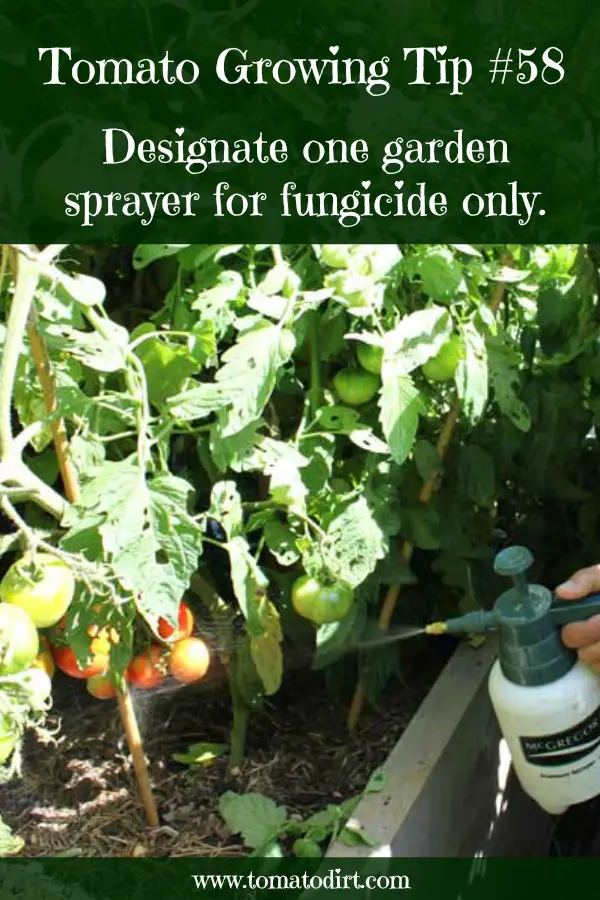FREE: 10 Must-Know Tomato Growing Tips Get The Guide
Read our affiliate disclosure here.
How to Choose and Apply Fungicide to Tomato Plants
Since 2010, Tomato Dirt has garnered 4.8+ million views, making it the web’s leading online source for growing tomatoes in the home garden. Award-winning writer and Tomato Dirt owner Kathy Widenhouse has helped thousands of home gardeners grow healthier tomatoes. Be one of them when you get Tomato Dirt’s Growing Guide here.
Updated 6.16.24
To keep your tomatoes healthy, thriving, and fungus-free, you can apply fungicide before any symptoms appear, and then continue treatment throughout the season.
Tomato fungi (early blight, late blight, and Septoria leaf spot) overwinter in the soil. They spread easily onto plants as water splashes up on leaves and stems, distributing pathogens. While these diseases cannot be cured once they attack a plant, they can be controlled.
Better yet, you can prevent them. To give your tomato plants a greater chance of resisting fungi, set up an anti-fungal treatment program and implement it early in the season. You can continue to treat plants to continue to prevent later fungal infection and to minimize any damage caused by funguses that chance to take hold.
Choose a Tomato Fungicide
The three most common types of tomato blight in tomatoes – early blight, late blight, and Septoria leaf spot – can be treated and controlled similarly with fungicides and by practicing good preventative care. These are the most effective fungicide treatments for tomato plants. (Here is primer on fungicides for tomatoes.)
Organic Fungicides
Copper fungicides are available in a variety of formulations. They are effective in preventing and treating both fungi and bacterial pathogens, which makes these products very valuable to the the home gardener. As you consider various copper fungicide products, be sure to check the ingredients.A copper sulfate formulation, on its own, can be more damaging to plants than a Bordeaux mixture, which combines copper sulfate with lime, neutralizing the acidic copper sulfate and reducing plant damage. One word of caution: young plants are particularly sensitive to copper, so be sure to dilute copper fungicides as you apply them early in the season.
Chemical Fungicides
Active ingredient chlorothalonil is the most recommended chemical for us on tomato fungus. It can be applied until the day before you pick tomatoes, which is a clear indication of its low toxicity. Chlorothalonil can be used as soon as tomato plants are subjected to humid or rainy conditions that can cause blight. Find it as a premixed product or in concentrated form to be mixed with water. Look for chlorothalonil under brand names Bravo, Echo, and Daconil. (Here's a selection.)
Other chemical fungicides available for home use are mancozeb and maneb, both requiring five days’ wait after application before harvesting.
Follow Basic Steps to Apply Fungicide
- When using all fungicides, follow product instructions. Different products are applied in different ways: as dust powders, in liquid spray, or as wettable powders.
- Always wear work gloves and protective eyewear as you apply fungicide.
- The lowest labeled rate of protectant fungicide, when used early in the season and then adjusted until tomato plants are finished producing, will provide protection and thus prevent a tomato fungus epidemic.
- Choose a garden sprayer and designate it for fungicide use only.
Applying Fungicide: FAQs
How do I know if I should use fungicide on my tomato plants?
If you know your garden (or your neighbor’s garden) has a history of early blight, late blight, or Septoria leaf spot, then your plants are vulnerable. Use a spray program.
When should I start applying fungicide?
Begin before symptoms appear, especially if your plants have had tomato fungus in the past or if you live in warm, humid areas where early blight, late blight, and Septoria leaf spot thrive. You can begin as soon as you set plants in the garden.
What parts of the plant should I spray?
Spray upper and lower leaf surfaces, stems, and flowers.
How much should I spray?
Thorough coverage is essential. Spray to the point of runoff.
How often should I apply fungicide?
Spray at 7 to 14 day intervals. Re-apply after rain.
More about Tomato Fungus and Tomato Blight
Use This 6-Step Checklist for Tomato Plant Care ...
Fungicide for Tomatoes: A Primer ...
Different kinds of tomato blight and how to tell them apart ...
How to identify and treat early blight ...
How to identify and treat late blight ...
How to identify and treat Septoria leaf spot ...
How to identify and treat gray leaf spot ...
How to choose a garden sprayer that is best for you ...
Identifying tomato plant diseases: compare 5 kinds of tomato wilt ...
Learn more about tomato diseases on our Pinterest board ...
Return from How to Choose and Apply Fungicide to Tomato Dirt home
As an Amazon Associate and Rakuten Advertising affiliate I earn from qualifying purchases.
SHARE THIS PAGE:
FREE! 10 Must-Know Tomato Growing Tips: 20-page guide
Get yours here:





New! Comments
Have your say about what you just read! Leave a comment in the box below.